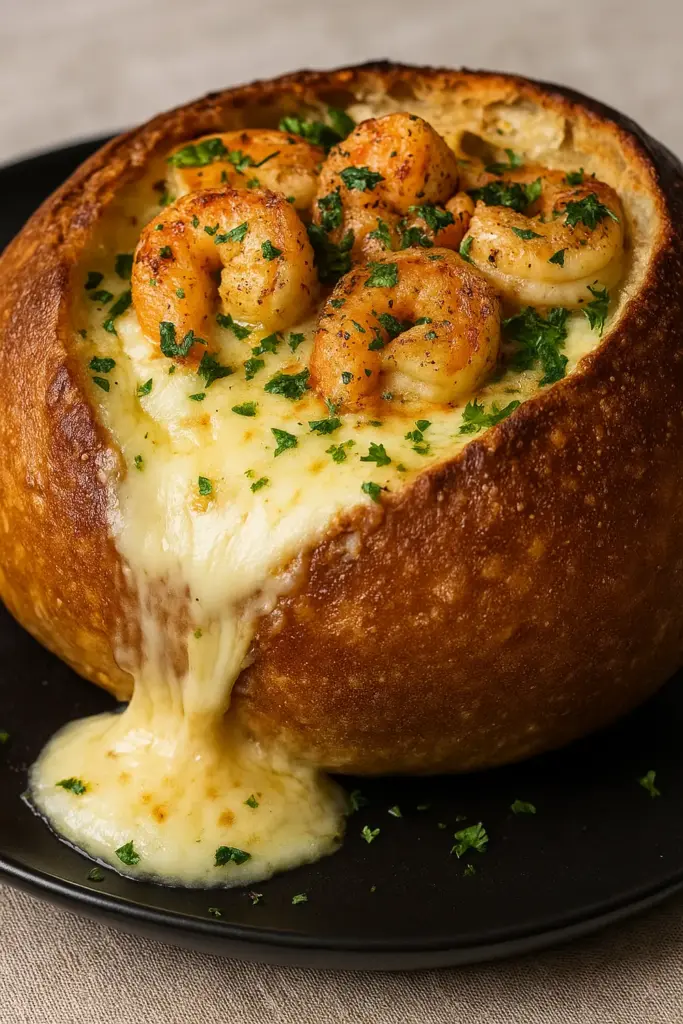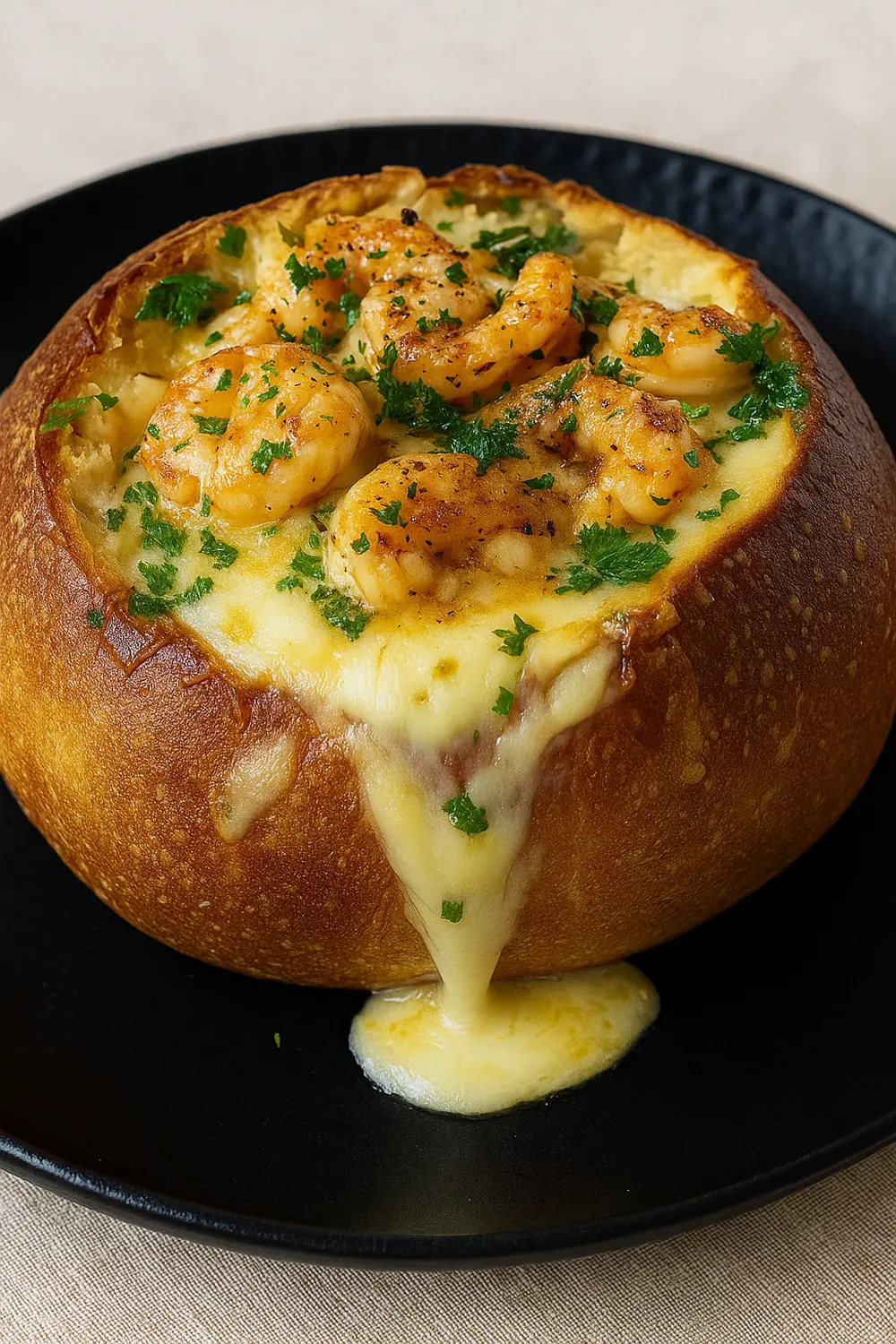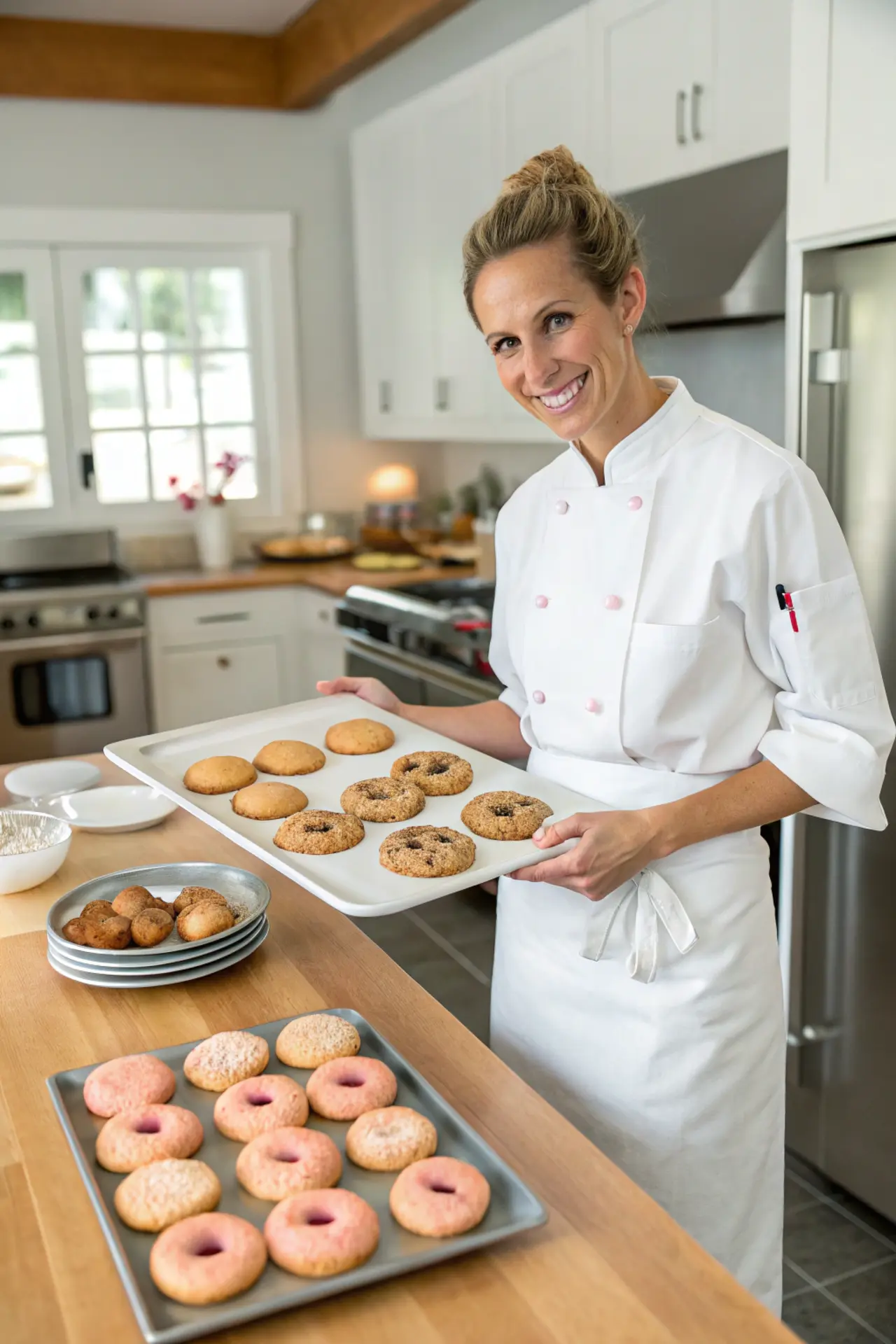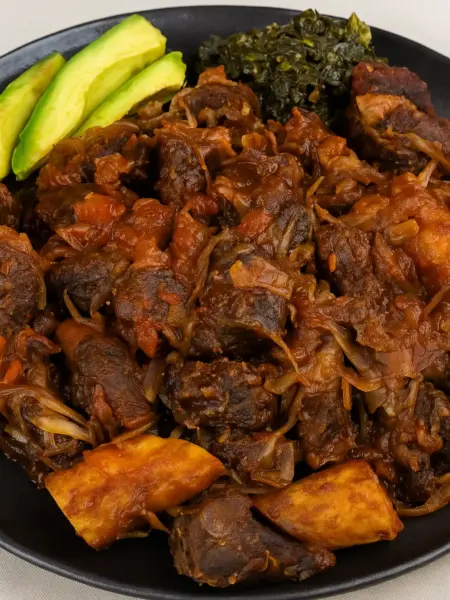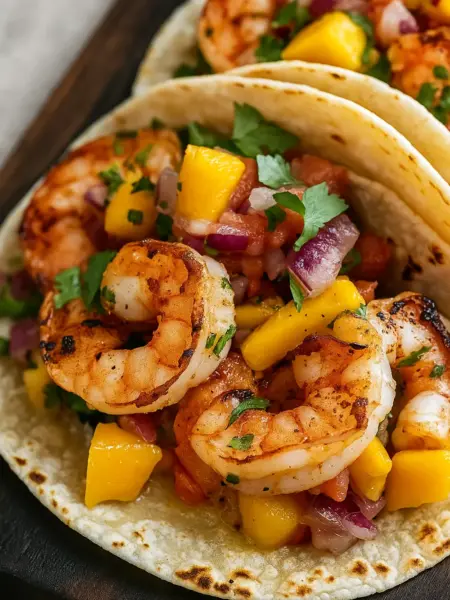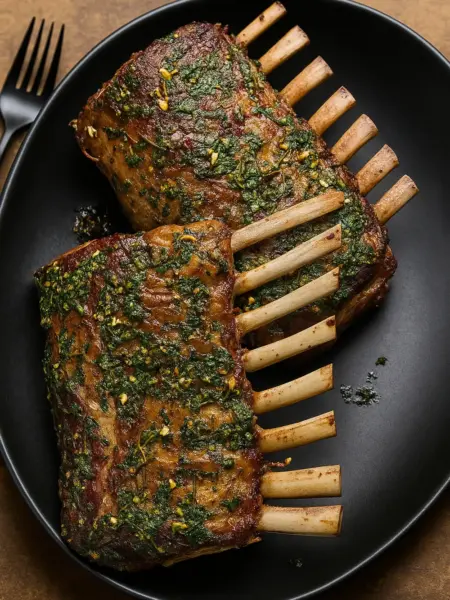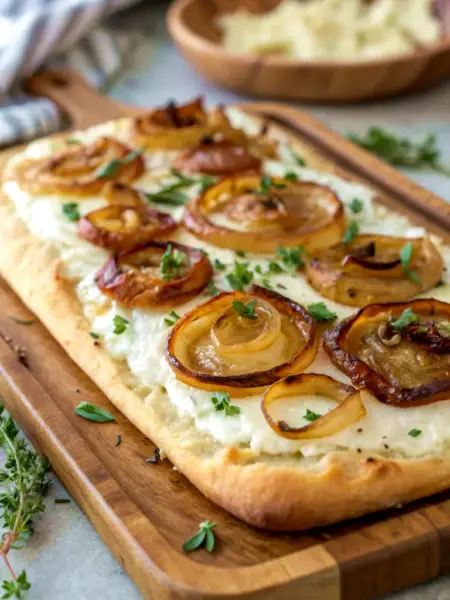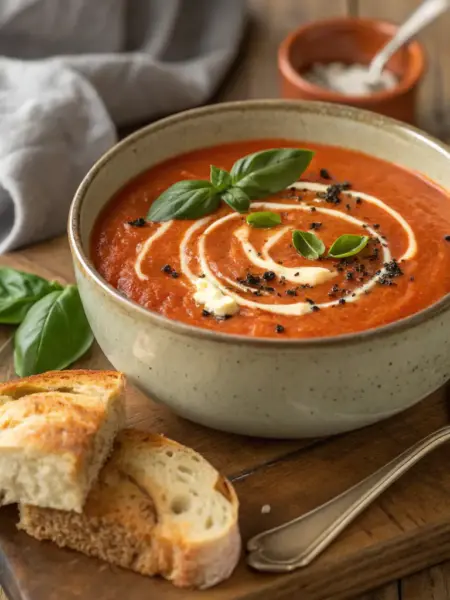This post may contain affiliate links, meaning I may earn a commission if you make a purchase, at no extra cost to you. I only recommend products I trust. Thank you for your support.
This stuffed seafood bread bowl recipe serves four, with each homemade sourdough bowl generously filled with a creamy, white wine–infused chowder brimming with shrimp, scallops, and crab meat.
It’s the perfect cozy, comforting dinner for a chilly night, but it also makes an impressive appetizer when you want to wow your family or guests.
When I first dreamed up this stuffed seafood bread bowl, I wanted to bring together two of my favorite things: a rustic, crusty sourdough boule and a rich, restaurant‑quality seafood filling.
For the bread, I use bread flour and sourdough starter to build layers of flavor through a slow fermentation, then gently shape and coax the dough so all those tangy notes stay intact.
For the chowder, I treat the vegetables like a classic French mirepoix, softening them gently to build a sweet foundation.
A quick roux thickens the broth just enough to keep it velvety, and a splash of white wine gives it that subtle “je ne sais quoi.”
Finally, I bring the bread and soup together so the crust stays sturdy enough to cradle the rich seafood filling, while the inside stays soft enough for your spoon to scoop up every last bit.
✅ Take a moment to read through the whole post first; you’ll pick up expert tips, handy equipment guides, and step-by-step details to help everything turn out perfectly. The full recipe is right below!
Key Ingredients for Your Stuffed Seafood Bread Bowl
Here are the core ingredients, and this stuffed seafood bread bowl is no exception. Here’s a closer look at what makes this dish sing:
1. Bread Flour
- If you’re baking your homemade bread bowls from scratch, start with good bread flour.
- It’s higher protein content helps build a strong gluten structure, which means your loaves will rise well and have a sturdy, chewy crust that can hold up to a rich, creamy filling without falling apart.
2. Sourdough Starter
- A healthy, active sourdough starter is the secret to developing that deep, tangy flavor that makes a homemade sourdough bread bowl so special.
- The slow fermentation brings out complex, slightly nutty notes and gives your bread a beautiful rise.
3. Crusty Boule (Sourdough Preferred)
- If you don’t want to bake the bread bowls from scratch, pick up a good-quality sourdough boule from your favorite bakery.
- Sourdough’s robust structure ensures it can hold the creamy filling without collapsing, while its characteristic tangy flavor beautifully complements the rich seafood sauce.
4. Large Shrimp
- Large shrimp hold their shape and size better when cooked, giving you those satisfying, juicy chunks in every spoonful instead of tiny bits that get lost in the chowder.
- Bigger shrimp stay plump and tender as they’re less likely to overcook and turn rubbery, which is key when you’re simmering them gently in a creamy broth.
5. Mixed Seafood
- Adding scallops and a bit of crab meat takes this dish from a simple shrimp chowder to a full-on stuffed seafood bread bowl medley that feels extra special and indulgent.
- Bay scallops provide a sweet, tender texture, while lump crab meat adds a luxurious richness and flaky consistency.
6. White Wine
- A splash of dry white wine is crucial for deglazing the pan, capturing all the browned bits of flavor left by the sautéed aromatics and seafood.
- The wine also brings a gentle acidity that cuts through the richness of the cream, giving the seafood filling a brighter, more balanced taste.
- It layers in a subtle depth that makes the sauce taste like it’s been simmering for hours, even though it comes together quickly.
- A crisp Sauvignon Blanc or Pinot Grigio works perfectly here; both are light, dry, and won’t overpower the delicate seafood flavors.
7. Heavy Cream
- Heavy cream provides the richness and body that makes this dish so indulgent.
- It creates a smooth, comforting base that coats the seafood and infuses the bread, transforming the flavors into a cohesive, decadent experience.
8. Aromatics
- Sautéing diced onion and bell pepper creates a sweet, savory base, while minced garlic adds a pungent, aromatic kick.
- They build the foundational layers of flavor that make the creamy seafood filling so complex and delicious.
9. Parmesan & Sharp Cheddar Cheeses
- These cheeses are more than just toppings; they are integral to the sauce’s flavor and texture.
- Parmesan offers a salty, umami depth, while sharp cheddar brings a tangy, robust creaminess.
- When melted correctly (off the heat to prevent graininess!), they create a silky, irresistible sauce that binds all the elements together.
10. Fresh Parsley
- Beyond just a garnish, fresh parsley adds a vibrant, herbaceous freshness that cuts through the richness of the creamy sauce.
- It provides a pop of color and a clean finish, brightening the entire dish.
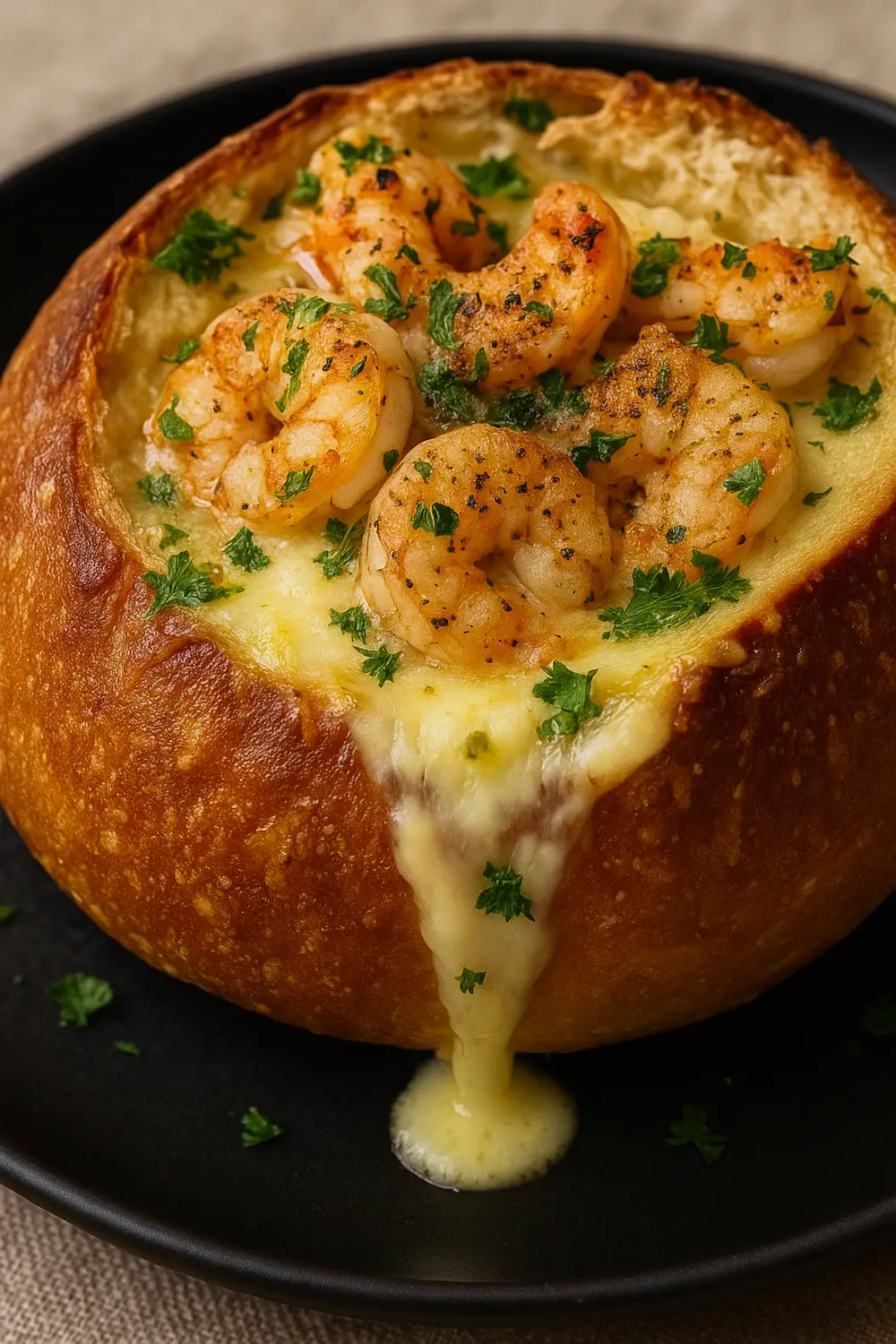
Essential Tools for This Sourdough Bread Bowl Recipe
Here are the essential kitchen tools you’ll want to have on hand for making this sourdough bread bowl recipe:
- Stand Mixer: If you’re making your sourdough bread bowls from scratch, a stand mixer with a dough hook makes the kneading process much easier.
- Large Mixing Bowl for Hand Mixing: If you prefer to mix by hand, a large, sturdy mixing bowl is essential for combining ingredients and allowing the dough to rise.
- Sharp Serrated Knife: This is your best friend for cleanly cutting the “lid” off your bread and hollowing out the interior without tearing the crust. A good serrated knife ensures a neat, functional bowl.
- Baking Sheets: You’ll need these to toast your hollowed-out bread bowls and the torn bread pieces, as well as for the final bake of the assembled dish. Parchment paper is also a great addition to prevent sticking and make cleanup a breeze.
- Large Skillet or Dutch Oven: This is where your creamy seafood filling comes to life. A spacious skillet or Dutch oven allows you to sauté your aromatics and seafood, and then build your rich sauce all in one pan.
- Whisk: Crucial for achieving a smooth, lump-free sauce, especially when incorporating the cheeses into the hot cream mixture.
- Measuring Cups and Spoons: Precision is key in baking and cooking, so accurate measuring tools ensure your ingredients are perfectly balanced.
- Cutting Board: A stable surface for safely chopping your vegetables and preparing your seafood.
- Cheese Grater: Freshly grated cheese melts more smoothly and tastes better than pre-shredded, so a good grater is a must for that silky sauce.
- Small Bowl (for egg wash): If you’re baking your sourdough bread bowls, a small bowl for whisking an egg wash can help achieve that beautiful golden crust.
- Dough Whisk or Spatula: A dough whisk (or a sturdy spatula) makes it easy to mix your starter, water, and flour together evenly when you’re starting your dough by hand.
- Plastic Wrap: Handy for covering your dough during bulk fermentation and final proofing, plastic wrap helps lock in moisture and keep your dough from drying out while it rises.
Why You’ll Love These Homemade Bread Bowls
Here’s why you’ll likely fall in love with these homemade bread bowls:
- Homemade Touch: Unlike mass‑produced café bread bowls, these are fresh from your oven, with a personalized sourdough tang.
- Crisp‑to‑Soft Contrast: Each bite starts with a crackle of crust, then yields to soft bread soaked in creamy seafood chowder, textural heaven.
- Crowd‑Pleaser Presentation: Let’s be honest, serving your soup right inside a fresh, warm bread bowl instantly turns an ordinary meal into something fun and memorable.
- Flavor‑Soaked Crumbs: You’ll find bits of soaked bread at the bottom that taste like liquid gold; no drop of that delicious chowder goes wasted.
- Hearty and Satisfying: Unlike a regular bowl of soup, a bread bowl turns it into a truly hearty meal. The combo of warm, crusty bread and rich, creamy chowder guarantees you’ll feel full, cozy, and completely satisfied.
- Less Dishes: Who doesn’t love having fewer dishes to wash? The bread bowl does double duty as both your bowl and your plate. Once you’ve enjoyed every last bite, there’s practically nothing to clean up.
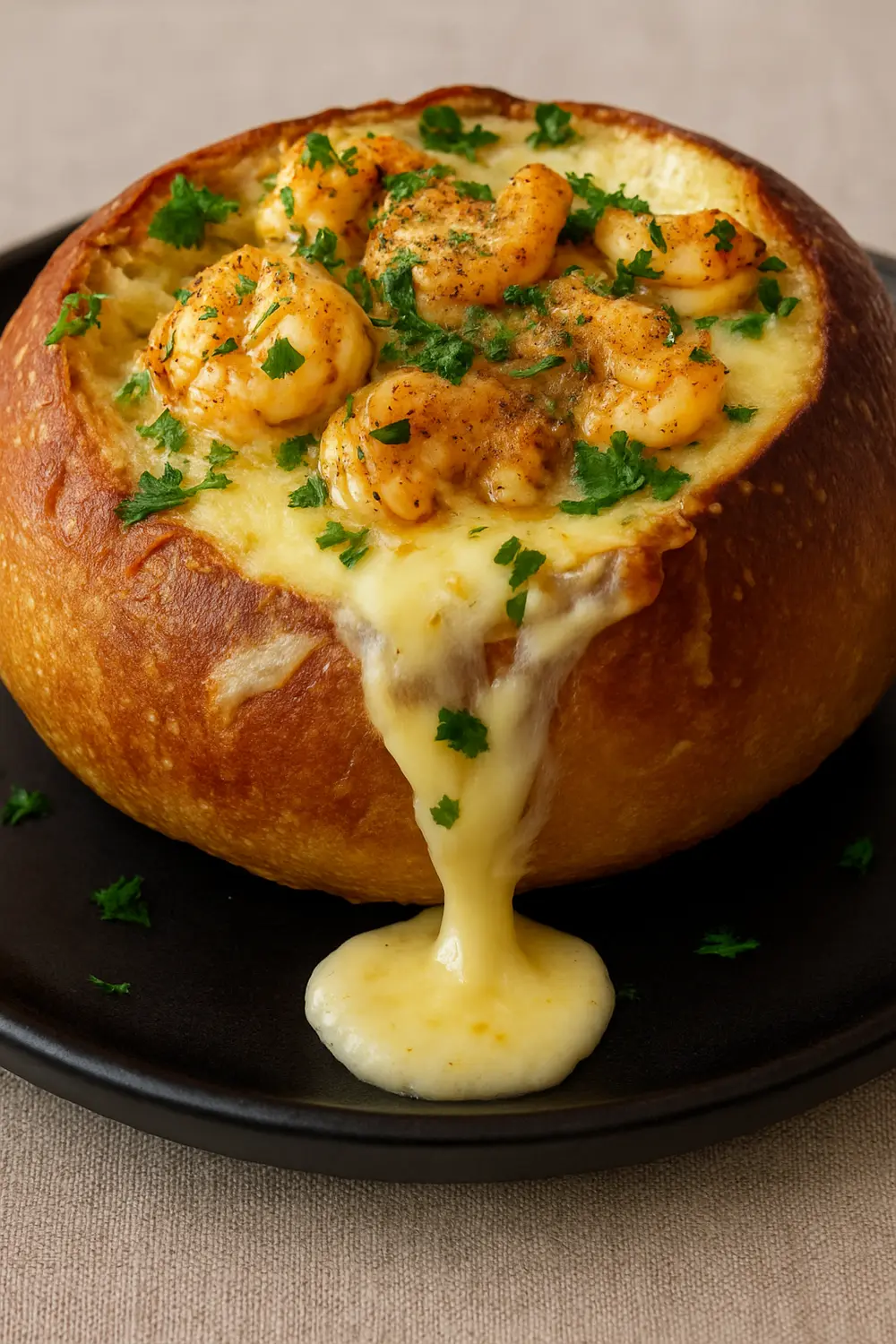
Nutritional Benefits of Bread Bowl Soups
While our stuffed seafood bread bowl is certainly an indulgent treat, bread bowl soups in general can offer some surprising nutritional benefits:
- Source of Carbohydrates for Energy: The bread bowl itself provides a substantial amount of carbohydrates, which are your body’s primary source of energy. A Panera bread bowl, for example, contains 130g of carbohydrates.
- Fiber Content: Bread, especially whole-grain or sourdough varieties, contributes dietary fiber. Fiber is important for digestive health and can help you feel full and satisfied. A Sourdough bread bowl contains 4g of dietary fiber.
- Protein Power: When filled with protein-rich ingredients like seafood, chicken, or beans, bread bowl soups become excellent sources of protein, essential for muscle repair, growth, and overall satiety.
- Vitamins and Minerals from Fillings: Vegetables such as bell peppers are rich in Vitamin C, and parsley provides Vitamin K and iron. Seafood like shrimp and scallops offer essential minerals like selenium, zinc, and B vitamins.
- Hydration: This stuffed seafood bread bowl soup is an easy way to sneak in extra fluids, especially comforting in cooler weather and surprisingly refreshing if you make a lighter version for the summer months.
What to Serve with Stuffed Seafood Bread Bowls
A rich and creamy stuffed seafood bread bowl is a meal in itself, but a few thoughtful accompaniments can elevate the dining experience and provide a lovely balance to the richness of the main dish.
- Fresh, Crisp Salad: A light, vibrant salad is the perfect counterpoint to the creamy, hearty bread bowl. Think a simple green salad with a zesty vinaigrette, or a Caesar salad with crisp romaine and a tangy dressing.
- Steamed or Roasted Vegetables: Offer a side of lightly steamed or roasted vegetables like asparagus, green beans, or broccoli. A touch of lemon and herbs can keep them bright and fresh, adding essential nutrients and a different texture.
- Crusty Bread for Dipping (the “Innards”): Don’t forget the bread you hollowed out! Toast these pieces until golden and crisp, and serve them alongside the bread bowls. They’re perfect for dipping into any extra sauce or for scooping up the last delicious bits of seafood.
- White Wine: A crisp, dry white wine like a Sauvignon Blanc or Pinot Grigio pairs beautifully with seafood and creamy sauces. Its acidity can cleanse the palate and enhance the flavors of the dish.
- Simple Dessert: After such a rich main course, a light and refreshing dessert would be ideal. Consider fresh fruit, a sorbet, or a small panna cotta to end the meal on a sweet, yet not overly heavy, note.
Chef Tips for Making the Best Homemade Bread Bowls
Homemade bread bowls are so satisfying to make, and these few simple tricks will help you get them just right every time:
1. Pick the Right Bread
- If you don’t want to bake from scratch, go for a round “boule” with a thick crust and a slightly dense, chewy inside.
- Sourdough is perfect because it’s strong enough to hold creamy soup without falling apart.
- Plus, that tangy flavor pairs beautifully with savory fillings. Avoid super-soft or fluffy breads as they’ll soak up too much liquid and collapse.
2. Always Toast the Inside
- After you hollow out your bread bowl, brush the inside (and even the outside, if you like!) with a little olive oil, then toast it in the oven.
- This quick step keeps the bowl from turning soggy by creating a barrier that locks out extra moisture. You’ll get a nice crisp shell that stays sturdy even with a rich, creamy seafood filling inside.
3. Don’t Waste the Bread Innards
- All that fluffy bread you pull out? Don’t toss it! Tear it into bite‑sized pieces, drizzle with a bit of olive oil, and toast them alongside your bowls.
- They make amazing croutons for dipping, adding extra crunch and ensuring nothing goes to waste.
4. Size Makes a Difference
- Think about how big you want your servings. Large boules are great for sharing between two or three people, while smaller individual bread bowls are perfect for single servings.
- If you’re baking from scratch, divide your dough to get just the right size for your meal.
5. Let Them Cool Completely
- If you’re baking your bread bowls yourself, be patient and let them cool fully on a wire rack.
- This helps set the crust and keeps steam from softening it, so when it’s time to fill them up, your bowls stay sturdy and crisp.
6. Serve Immediately
- This stuffed seafood bread bowl is at its absolute best straight out of the oven.
- The bread bowl is crispiest, the filling is piping hot, and the flavors are at their peak.
7. Keep the Cheese Sauce Smooth
- For a silky, lump-free sauce, always take the skillet off the heat before adding the grated Parmesan and cheddar.
- This simple step keeps the cheese from seizing up and turning grainy.
Final Remarks
This homemade stuffed seafood bread bowl recipe is cozy, flavorful, and just special enough to make any weeknight or gathering feel memorable.
It’s proof that good bread, fresh seafood, and a little extra care in the kitchen can turn an ordinary meal into something you’ll crave again and again.
It’s the kind of comforting dish that invites you to slow down, pour a glass of wine, and enjoy every step, from prepping the sourdough to stirring up that creamy seafood chowder.
So next time you want something a little extra special, bake up your bread bowls and share a warm, satisfying meal that brings everyone to the table.
The Best Stuffed Seafood Bread Bowl
This stuffed seafood bread bowl recipe serves four generous portions, each with a homemade sourdough bowl overflowing with creamy white wine chowder, shrimp, scallops, and sweet crab meat.
Ingredients
For the Homemade Sourdough Bread Bowls
For the Stuffed Seafood Filling
How To Make Stuffed Seafood Bread Bowls (Step-By-Step Instructions)
Activate Your Starter
- Make sure your sourdough starter is active and bubbly.
- A good test is to gently drop a spoonful into a glass of water; if it floats, it's ready to use.
- This means it’s strong enough to give your bread the rise it needs.
Mix the Dough
- In a large mixing bowl, stir your active starter into warm water using a dough whisk or spatula until it’s evenly dispersed.
- Add the bread flour and salt on top, then mix until everything comes together into a shaggy, sticky dough with no dry patches.
Knead the Dough
- Turn the dough out onto a lightly floured surface and knead it by hand for about 5 to 6 minutes, until it’s smooth and elastic.
- Alternatively, you can use a stand mixer with a dough hook and mix on medium-high speed for 8 to 10 minutes until the dough is mostly smooth and doesn't stick to the sides.
Let It Rise (First Proof)
- Brush a little olive oil inside a bowl.
- Then place your kneaded dough inside the bowl and cover it with plastic wrap or a damp kitchen towel.
- Let the dough rise in a warm place.
- For sourdough, this fermentation can take over 4 hours depending on your starter's activity and ambient temperature.
- The dough should significantly increase in volume, ideally doubling in size.
Divide and Shape
- Gently press down the risen dough to release excess air.
- Move it to a floured work surface and cut it into 4 equal pieces, about 265 grams each for single bread bowls.
- Shape each piece into a tight round loaf.
- To do this, gather the dough from the sides and fold it up and over to the center, repeating until a round forms.
- Flip it over and, using the palms of both hands, roll the dough in tight circles against the work surface.
Second Rise (Final Proof)
- Place your shaped loaves on a parchment-lined baking sheet, leaving enough space between them.
- Cover them loosely with kitchen towels or plastic wrap.
- Let them rise in a warm spot until doubled and puffy for about 40 minutes or 1 hour.
Preheat the Oven
- While your loaves do their final rise, arrange your oven racks so you can bake in the center and preheat the oven to 400°F (200°C).
Bake Until Golden
- Once the loaves are risen, uncover them.
- Gently brush the tops with the egg wash for a beautiful golden crust.
- Using a sharp knife or bread lame, score a 2-inch-long "X" on top of each loaf.
- Let them rest for 5 minutes.
- Bake for 25 to 30 minutes, or until the tops are golden-brown and the internal temperature reaches 190°F (88°C).
Option 2: Use a Dutch Oven for Extra Crunch
- If you want an extra crispy crust, bake your loaves in a preheated Dutch oven.
- Place the dough inside, cover with the lid, and bake for 40 minutes.
- Remove the lid and bake for another 15 minutes until the crust is deeply golden.
Cool Completely
- Transfer your homemade bread bowls to a wire rack and let them cool for at least one hour before you hollow them out.
- Cooling fully helps set the structure so your bowls stay sturdy and don’t turn soggy once you ladle in that creamy seafood chowder.
Prepare the Seafood Filling
- In a large skillet or Dutch oven, melt butter with olive oil over medium heat.
- Add diced yellow onion and bell pepper.
- Sauté for 5 to 7 minutes until softened and translucent.
- Stir in minced garlic and cook for another 1 minute until fragrant.
- Add the shrimp, scallops, and crab meat.
Season & Simmer
- Stir in Old Bay seasoning, smoked paprika, salt, and pepper.
- Cook for 2 to 3 minutes, stirring occasionally, until the shrimp just begins to turn pink and the scallops are opaque.
- Remove the cooked seafood and set aside in a bowl.
Deglaze with White Wine
- Into the same skillet, pour in the white wine.
- Bring to a simmer and deglaze the pan, scraping up any browned bits from the bottom.
- Allow it to simmer for 2 to 3 minutes to reduce slightly.
Make the Creamy Base
- Once the wine has reduced a bit, whisk in the heavy cream and chicken broth directly into that same skillet.
- Bring the mixture to a gentle simmer, then reduce heat to low.
- Cook for 5 to 7 minutes, stirring occasionally, until the sauce slightly thickens.
Add the Cheeses
- Take the skillet off the heat.
- Gradually whisk in the Parmesan and cheddar cheeses until they melt completely and the sauce turns smooth and creamy.
- Taking the pan off the heat first helps prevent graininess.
- Stir in the fresh lemon juice and chopped parsley.
- Taste and adjust seasoning (salt and pepper) as needed.
Combine Seafood and Sauce
- Gently fold the cooked seafood back into the creamy sauce.
Hollow the Bread Bowls
- Using a sharp serrated knife, carefully cut a circular opening, approximately 4 inches wide, into the top of each cooled loaf.
- Remove the "lid" and any pieces of bread that may be attached to it.
- Then gently hollow out the inside of each bread bowl, leaving a sturdy ½ to ¾-inch thick wall.
- The removed bread and lids should not be discarded; tear them into bite-sized pieces.
Fill the Bread Bowls and Bake
- Carefully spoon the creamy seafood filling into each toasted bread bowl and fill generously.
- Preheat the oven to 375°F (190°C).
- Place the filled bread bowl onto a baking sheet.
- Bake for 15 minutes, or until the seafood filling is visibly golden and bubbling around the edges.
- Once the stuffed seafood bread bowl is baked to perfection, carefully remove it from the oven.
Garnish & Serve
- Garnish with extra fresh parsley before serving.
- Serve immediately with the toasted bread pieces for dipping.
Nutrition Facts
Servings 4
Serving Size 1 stuffed bread bowl
- Amount Per Serving
- Calories 850kcal
- % Daily Value *
- Total Fat 48g74%
- Saturated Fat 24g120%
- Trans Fat 0.5g
- Cholesterol 250mg84%
- Sodium 980mg41%
- Potassium 400mg12%
- Total Carbohydrate 58g20%
- Dietary Fiber 5g20%
- Sugars 3g
- Protein 40g80%
- Vitamin A 1200 IU
- Calcium 300 mg
- Iron 3 mg
- Vitamin K 50 mcg
* Percent Daily Values are based on a 2,000 calorie diet. Your daily value may be higher or lower depending on your calorie needs.
Note
- Your homemade bread bowls rely on an active starter, so always float-test it before mixing your dough.
- Sourdough needs time. Don’t rush the rises, as a slow fermentation builds better flavor and texture, so adjust proofing to suit your kitchen’s temperature.
- When shaping your dough into rounds, use a gentle circular motion to build surface tension so your loaves hold their shape and bake up with a nice, tight crust.
- Scoring the tops lets the bread expand evenly in the oven, prevents random cracks, and gives your loaves a neat, professional look.
- Let your sourdough bread bowls cool fully on a wire rack so steam escapes, the crumb sets, and they stay sturdy enough to hold your filling without getting soggy.

